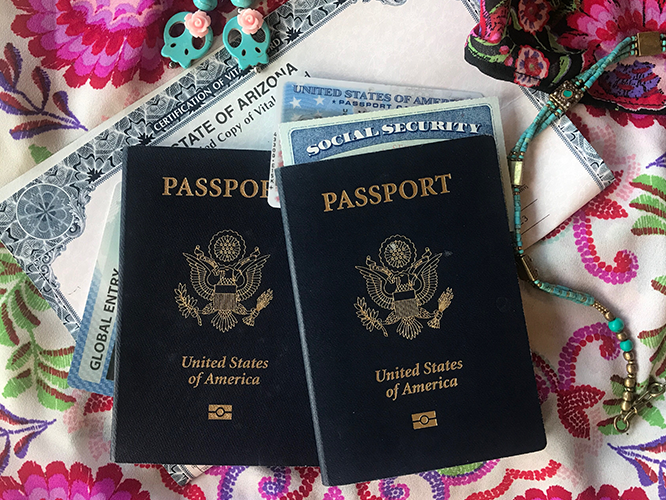
For Puerto Peñasco travelers, this question that comes up A LOT. But here’s the thing, I know from personal experience that customs agents don’t force you to stay in Mexico when can’t you present a passport to the U.S. border agents. So what is the real deal here? Who needs a passport and when? I did a little research and here’s what I found.
Even though the U.S. State Department requires it, U.S. citizens will not necessarily be denied re-entry at the U.S. – Mexico border if you do not have a passport. Mexico, however, does require passports when visiting, even if they don’t check it when you cross the border.
So while it’s possible to head south of the border without ever having to whip out your passport, here are some thing you should know before rolling the dice and traveling without one.
You would think it’s would be more clear on whether or not you truly need a passport to travel to Puerto Peñasco or to return to the U.S. When I say that this question comes up all the time, people ask it so often that it has actually become a drinking game on Rocky Point forums and social media groups. The rules of the game are simple. Every time someone asks, “Do I need a passport?”… Drink! However, when we all know a person (…or ten) that have passed back into the U.S. without a passport, you have to wonder “What the heck?”
Can you come back to the US from Mexico without a passport? Here’s What Customs Told Me
I fired off an email to the U.S. Customs and Border Protection (CBP) to find out if they can really be denied entry by land at the border port of entry if I don’t have a passport.
Considering how many people I know that have crossed the border without a passport, you would think they would have the answer posted on the FAQ page. But they don’t.
I sent them the following, “As a U.S. Citizen, can I be denied entry by land at the border entry ports if I do not have a passport or passport card? I continuously hear first-hand accounts of U.S. Citizens being allowed to pass without a passport or passport card. Sometimes with a driver’s license and/or birth certificate.”
CBP will not refuse entry to a United States citizen if he or she does not have any of the required travel documents. However, a United States citizen requesting entry without a valid travel document will experience a delay at the port of entry, until the CBP Officer can verify the claim of citizenship. At the very least, United States citizens are advised to carry a valid driver’s license and birth certificate to prove citizenship and to assist the admitting CBP Officer with expediting re-entry to the United States.
U.S. Department of Homeland Security Requirements
The U.S. Department of Homeland Security (DHS) and U.S. Department of State (DOS) specifically requires one of the following forms of ID for U.S. citizens when entering the U.S. by land.
- U.S. Passport
- Passport Card
- Enhanced Driver’s License
- Enhanced Driver’s Licenses (EDLs) are issued as proof of identity and U.S. Citizenship. They have an RFID chip and currently only issued to citizens who live in Michigan, Minnesota, New York, Vermont and Washington.
- Trusted Traveler Program Card
- These include NEXUS, SENTRI or FAST cards. CBP will also accept Global Entry cards. In order to obtain any of these kind of cards, you do need a passport. For us, having a Global Entry card came in handy when my husband misplaced his passport card. These cards also have the RFID chip, so they can be scanned and you will already be pulled up in the system before you get to the CBP officer at the gate.
- Form I-872 American Indian Card, or Enhanced Tribal Card
DHS Passport Requirements for Kids
Kids under the age of 16 (or under 19, if traveling with a school, religious group, or other youth group) that are U.S. citizens only need a birth certificate or other proof of citizenship. (The birth certificate can be original, photocopy, or certified copy.) There may be other requirements for traveling with kids when they are not traveling with their natural parents.
What to Expect When You Don’t Have a Passport to Re-Enter the U.S.
As the U.S. CBP representative explained in the response above, you can’t be denied re-entry.
That said, understand that in the name of national security, the CBP officer at the gate are required to determine if your declared citizenship is legitimate. This could be just answering a few simple questions to being detained for further investigation and inspection.
Either way, it takes considerably more time to get cleared to cross the border back in to the U.S.
In addition, you slow down the line, my friend. You become “That Guy” the makes the border line wait even longer for the rest of us.
“Proof” of Citizenship
But, if you simply don’t have any ability to get your passport or passport card, bring a government issued picture ID and something stating your legal right to be in the U.S., like a birth certificate or social security card.
Be warned though. A CBP officer explained to my girlfriends that their birth certificates and social security cards were hot ticket items for thieves in Mexico. (Then he shamed me for being a bad friend with a passport and bringing my amigas down without one.)
So protect your documents well.
An Expired Passport Can Still Be Useful
If you are going to go without a passport, consider carrying your expired passport. You can still be delayed, but another CBP officer explained to us that even an expired passport makes it quicker to verify you in the system.
Mexico Requirements for U.S. Citizens
Getting back into the U.S. is not the only reason a passport may be required. As a visiting guest of Mexico, your host country has their own requirements.
U.S. Passport While in Mexico
According to the Mexico Secretary of Exterior Relations, U.S. citizens must have a passport that is valid for at least 6 months.
No Mexican Visa for Short Trips to Puerto Peñasco
You will not, however, need a visa if your trip meets the following requirements:
- You are a U.S. or Canadian citizen
- The purpose of your visit is tourism, studies or business.
- The duration of your stay does not exceed 180 days
Instead, you will need what is known as Multiple Migratory Form (FMM).. Which is a temporary Mexican tourist permit.
Prior to 2015, this permit was not required for entry into Mexico’s “free zones” unless your stay was longer than 72 hours.
A lot of major websites say you don’t need an FMM if you stay in Rocky Point less than 72 hours. But, I was not able to officially confirm that this is still the case.
If you frequently cross the Lukeville border to Puerto Peñasco, you probably notice that post people don’t stop for this permit. The most likely reason they don’t enforce it at Lukeville is that it would cause a huge back up at the 2 lane entry point into Mexico.
You can start the process for the FMM online HERE. (Be sure to click the “EN” box at the top right to get the English version) You will need a passport when you have this permit stamped at the border office.
Taking Your Car to Mexico
When driving your car to Rocky Point, remember that if you plan to the area, be aware of the boundaries of the International free zone of foreign vehicles. (See MAP)
As long as your vehicle remains in within this area, you will not be required to obtain a vehicle import permit. You will need your passport for this permit.
Reasons You Need A Passport in Puerto Peñasco
- Faster border processing to re-enter the U.S.
- Required for Mexican Tourist Permit or FMM
- Required for vehicle permits when traveling outside the Sonora “free zone”
- To exchange dollars to pesos in Puerto Peñasco
Rules vs Reality
So now you know that while you need all of these things when you travel to Rocky Point, it is highly likely that you will never even have to show a passport while in Mexico. And you can probably cross the border back into the states without one.
And if you ask around, you’ll get answers like, “It’s Mexico. The rules change on a daily basis. Keep your head down, don’t run stop signs and never drive drunk. You will be ok.”
That said, these are still laws. Even though they are not enforced 100% of the time, it would be best practice to get your passport. The U.S. requires it, Mexico requires it. And you may not want to be caught without it that one time they decide to enforce it.


